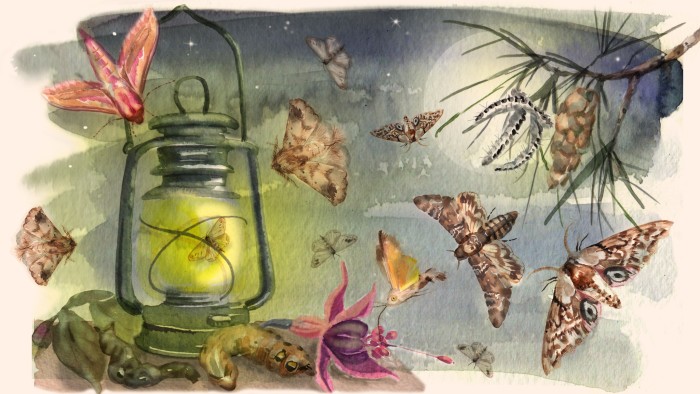Stay informed with free updates
Simply sign up to the House & Home myFT Digest — delivered directly to your inbox.
Blindly, we follow the leader. But the leader is blindly following the cues of everyone else. Round and round in a circle we go.
The caterpillars of the pine processionary moth exemplify this futile behaviour. They have provided a handy illustration of misguided followership for many a public speaker and pundit — including, ironically, some who themselves depend on misguided followers for support and direction.
Circular route marches are one way moths surprise, impress or infuriate humans. But we have a relatively low awareness of the vast and complex world of moths, given their largely nocturnal habits. Humans, to the regret of nightclub owners, are primarily diurnal.
Moths are most visible in the northern hemisphere at this time of year, when adults take to the wing and are attracted to the lights of our dwellings. Enjoy for a moment the subtle beauty of their patterns and ponder the briefness of their adult lives, before they flutter back into the dark.

Most moths shun attention. In flight, some species use their furry bodies to absorb the sonar pulses of bats — a form of acoustic camouflage. At rest, subtle gradations of tone and colour break up outlines among branches and foliage. This inspired long-dead entomologists to bestow such evocative names as the gothic, the flame brocade and the shaded fan foot.
My own theory — which, as yet, lacks scientific verification — is that wing patterns convey desperate messages from the moths that we humans are tragically unable to decode. For example: “There is No Planet B!” Or: “The End is Nigh!”
You can attract moths to your garden or balcony with a bright torch pointed at a white sheet hung on a washing line. Or go one better and invest in a light trap. On darker nights, moths will spiral into it as they mistake the lightbulb for their usual navigational aid, the moon. It is fun seeing what moths the trap contains before releasing them in the morning, particularly if nature-curious kids participate.
You can identify moths the old-school way using field guides, such as Richard South’s classic The Moths of the British Isles. The modern alternative is online ID via websites such as Picture Insect. The contents of my dad’s moth trap stoked my own passion for these insects. I cannot pretend I was always as studiously interested in what I call SGJs (small grey jobs) as I am now. Instead, my interest was fostered by hawkmoths. These are spectacularly large and beautifully patterned. Their wings are scalloped to resemble flaking tree bark or swept back like those of jet fighters.
The best known is the death’s-head hawkmoth, named after skull-like markings on its back. They are more loveable than their doomy folkloric reputation suggests. Their bodies are covered in brown and orange fur. Hold one in your hand — they are the size of small mice — and they may squeak in protest.
You are more likely to encounter the elephant hawkmoth, a pretty pink and green animal. It is named after its caterpillar which, when disturbed, hunches its back to show off defensive eyespots, head and neck waving like a trunk. During the pandemic, I depleted my local garden centre’s stock of potted fuchsias raising a ravenous band of elephant hawkmoth caterpillars. “We sometimes wonder whether you love your caterpillars more than us,” my teenagers complained. “I love you all equally,” I replied, not wishing to offend either constituency.
Some caterpillars are prized more than others. China fiercely guarded the secrets of silk worm cultivation until spy monks smuggled some of the animals to Constantinople and thence to Europe.
Moth caterpillars are an important food source for wild birds everywhere and for humans in a few places. Mopane “worms” are widely consumed in southern Africa. An acquaintance was fed them by his mother when he was a boy. He is grateful she no longer does so now he is a man.
Adult moths deliver services of incalculable value by pollinating plants. Their larvae can cause lesser but more easily assessed losses as agricultural and horticultural pests. I sympathise with gardeners whose carefully clipped box hedges have been ravaged.
Some very hungry caterpillars make depredations indoors too. Before we opted for hardwood floors, our house hosted so many carpet moths we considered applying for National Collection status.
Processionary caterpillars attacked with equal brio the garden pine trees nurtured by Jean-Henri Fabre. The great French naturalist retaliated with the account of circular marching that established their reputation as the stupidest of creatures. His caterpillars processed around the rim of a vase for a week before choosing a better route.
Yet here in the high Pyrenees, where I am holidaying, many pines are adorned with the impenetrable nests of these animals. They are so much a part of the landscape that hikers blob some nests with paint as route markers. Most of the caterpillars — whose hairs can deliver dangerous stings — manage to move earthward to pupate without marching round in circles.
That teaches a different lesson to the one that ephemeral speechifiers usually spin in relation to this enduring creature: instinctive survivors often have the last laugh.
Find out about our latest stories first — follow @FTProperty on X or @ft_houseandhome on Instagram
